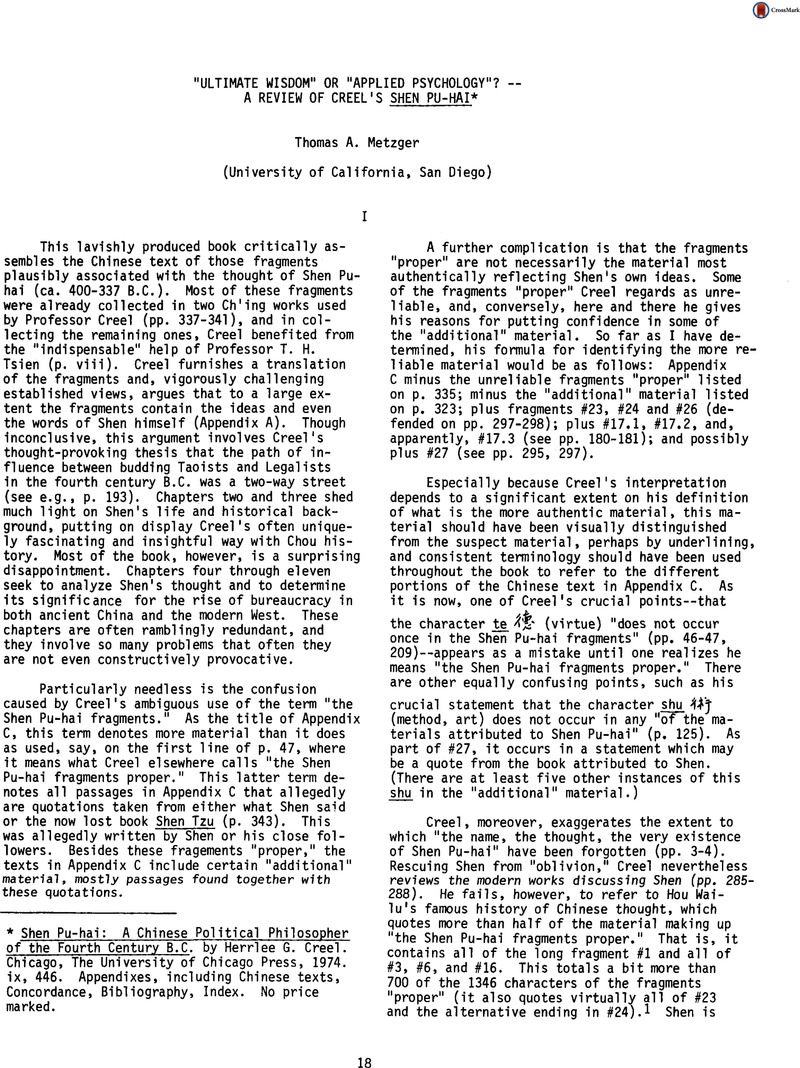No CrossRef data available.
Article contents
“Ultimate Wisdom” or “Applied Psychology”? -- A Review ofCreel's Shen Pu-Hai
Review products
Published online by Cambridge University Press: 26 March 2015
Abstract

- Type
- Review Articles
- Information
- Copyright
- Copyright © Society for the Study of Early China 1976
References
FOOTNOTES
1. Wai-lu, Hou et al., Chung-kuo ssu-hsianq t'ung-shih, 5 vols. (A comprehensive history of Chinese thoughtGoogle Scholar; Peking, , Jen-min ch'u-pan she, 1957–1960), 1:595–599 Google Scholar. Creel mentions another work co-authored by Hou Wai-lu.
2. Jung-ch'üan, Hsiao, Chung-kuo chenq-chih ssu-hsiang-shih, 4 vols. (A history of Chinese political thought; Taipei, Chung-hua ta-tien pien-yin-hui, 1966), 2:225–226, 2:229, 2:242 Google Scholar. Hsi-sheng, T'ao, Chung-kuo chenq-chih ssu-hsianq-shiht 4 vols. (A history of Chinese political thought; Taipei, T'ai-wan lien-ho shu-chü, 1964), 1: 215–216 Google Scholar. A similar view of Shen Pu-hai as one of the most important precursors of Han Fei can be seen in other modern Chinese histories of political thought, such as Fan-k'ang, Tseng, Chung-kuo chenq-chih ssu-hsiang-shih (A history of Chinese political thought; Taipei Chung-kuo t'u-shu yu-hsien kunq-ssu, 1959), p. 218 Google Scholar, and Ta-hua, Wang and Shih-chang, Wan, Chung-kuo chenq-chih ssu-hsianq-shih (A history of Chinese political thought; Taipei, published by the authors, 1968), p, 398 Google Scholar.
3. Ch'ang-ling, Ho, ed., Huang-ch'ao ching-shih wen-pien, 8 vols. (Our august dynasty's writings on statecraft; Taipei, Shih-chieh shu-chü, 1964), 2:2b, 2:12 Google Scholar.
4. Hsiao Kung-ch'üan, 2:194. See also Metzger, T. A., The Internal Organization of Ch'ing Bureaucracy (Cambridge, Mass., Harvard University Press, 1973), pp. 65–66 CrossRefGoogle Scholar.
5. Ch'i-ch'ao, Liang, Hsien-Ch'in chenq-chih ssu-hsiang-shih (A history of pre-Ch'in political thought in China; Taipei, Chung-hua shu-chü, 1956), p. 137 Google Scholar.
6. Creel, H. G., Confucius: The Man and the Myth (N. Y., The John Day Co., 1949), p. 122 Google Scholar.
7. See Kuan Tzu (Ssu-pu pei-yao ed.), 15:8 and Etzioni, Amitai, Comparative Analysis of Complex Organizations (N. Y., Free Press of Glencoe, 1961), pp. 12–13 Google Scholar. This convergence is described in Metzger, p. 247.
8. Chen, John T. S., 1001 Chinese Sayings (Hong Kong, The Chinese University of Hong Kong, Chung Chi College, 1973)Google Scholar. James, William, The Varieties of Religious Experience (N. Y., Mentor Books, 1958), p. 307 Google Scholar.
9. See T'ang Chün-i's valuable comments on ming (brightly intelligent) in Moore, C. A., ed., The Chinese Mind (Honolulu, East-West Center Press, University of Hawaii Press, 1967), p. 272 CrossRefGoogle Scholar and his discussion of the late Chou use of li (principle, etc.) in his Chung-kuo che-hsüeh yüan-lun tao-lun-p'ien (Studies on the foundations of Chinese philosophy, introductory volume; Kowloon, Tung-fang jen-wen hsüeh-hui, 1974). pp. 5–26 Google Scholar. This is another major Chinese work not in Creel1s bibliography. T'ang's article on Hsün Tzu's concept of the mind is in The Journal of the Institute of Chinese Studies of the Chinese University of Hong Kong IV, no. 1 (09 1971), pp. 1–21 Google Scholar. For Hsün Tzu's use of li as “principle,” see Chu-tzu chi-ch'eng, 8 vols. (A complete collection of the works of the ancient scholars; Peking, Chunq-hua shu-chü, 1959), 2:270, 2:267, 2:265, 2:258 Google Scholar.
10. See also chapters 45, 16, 37, and 48. I have used Ch'ien-chih, Chu, comp., Lao Tzu chiao-shih (Shanghai, Lung-men lien-ho shu-chü, 1958 Google Scholar) and Wing-tsit Chan, comp., A Source Book in Chinese Philosophy (Princeton, Princeton University Press, 1963), pp. 139–176 Google Scholar.
11. Chu-tzu chi-ch'eng, vol. 6, Lü-shih ch'un-ch'iu, pp, 174–176, pp. 170–172 Google Scholar; ibid., vol. 7, Huai-nan Tzu, pp. 127, 10; ibid., vol. 5, Shen Tzu, p. 3; Kuan Tzu, 13:4-5b; Takigawa, Kametaro, comp., Shiki kaichū kōshō 10 vols. (The records of the historian Ch'ien, Ssu-ma, with collected commentaries and textual notes; I-wen yin-shu-kuan, nd), vol. 10, chüan 130:13 Google Scholar. This Snih-chi passage is interesting also as containing a precursor of the famous distinction between t'i (substance) and yung (function, implementation), which is usually traced to Wang Pi (226-249). Ssu?ma T'an uses pen (ultimate basis) and yung (application in experience, function): “The method of the [Taoists] was to take emptiness and non-action as the ultimate basis, reliance on spontaneous tendencies (yin-hsün) as the way of dealing with actualities.” For similar examples of yin in Han Fei Tzu, see Chu-tzu chi-ch'ehg, vol. 5, Han Fei Tzu chi-chieh, pp. 156, 18Google Scholar.
12. Kuan Tzu, 13:2b. Chu-tzu chi-ch'eng, vol. 7, Huai-nan Tzu, chüan 9, p. 127 Google Scholar.
13. For a useful article on this field, see Jones, William C.' review of my The Internal Organization of Ch'ing Bureaucracy in Washington University Law Quarterly, 1974, no. 3, pp. 517–540 Google Scholar.
14. Keng-wang, Yen, Chung-kuo ti-fang hsing-cheng chih-tu-shih -- chüan shang: Ch'in Han ti-fang hsing-cheng chih-tu, 2 vols. (A history of regional and local administration in China -- part one: the Ch'in and Han periods; Taipei, Academia Sinica, The Institute of History and Philology, 1961), 2:257 Google Scholar.
15. Seemingly Invalid, therefore, Creel's argument cannot be used to support one of his crucial points, the Idea that much of #17 does not reliably reflect Shen's own views. As mentioned above, Creel's other main argument against the authenticity of #17 (pp. 182-183) seems to be based on a mistranslation.
16. For the distinction between “radicalism” and “moderate realism,” see Metzger, pp. 74-79.




